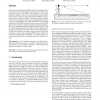70 search results - page 6 / 14 » Distance perception in real and virtual environments |
ISMAR
2003
IEEE
14 years 23 days ago
2003
IEEE
In this paper, we describe the effects of shadow representation of virtual objects in Augmented Reality. Optical consistency is important in order to create realistic augmented re...
ASSETS
2006
ACM
14 years 1 months ago
2006
ACM
In previous work we have presented a prototype of an assistant system for the blind that can be used for self-localization and interactive object identification of static objects ...
VR
2002
IEEE
13 years 7 months ago
2002
IEEE
When people move there are many visual and non-visual cues that can inform them about their movement. Simulating self motion in a virtual-reality environment thus needs to take th...
APGV
2008
ACM
13 years 9 months ago
2008
ACM
Most head-mounted displays (HMDs) suffer from substantial optical distortion, and vendor-supplied specifications for field-of-view often are at variance with reality. Such display...
APGV
2006
ACM
13 years 11 months ago
2006
ACM
Distances in immersive virtual environments (VEs) have been commonly reported as being spatially compressed while the same judgments are performed accurately in real space. Previo...

